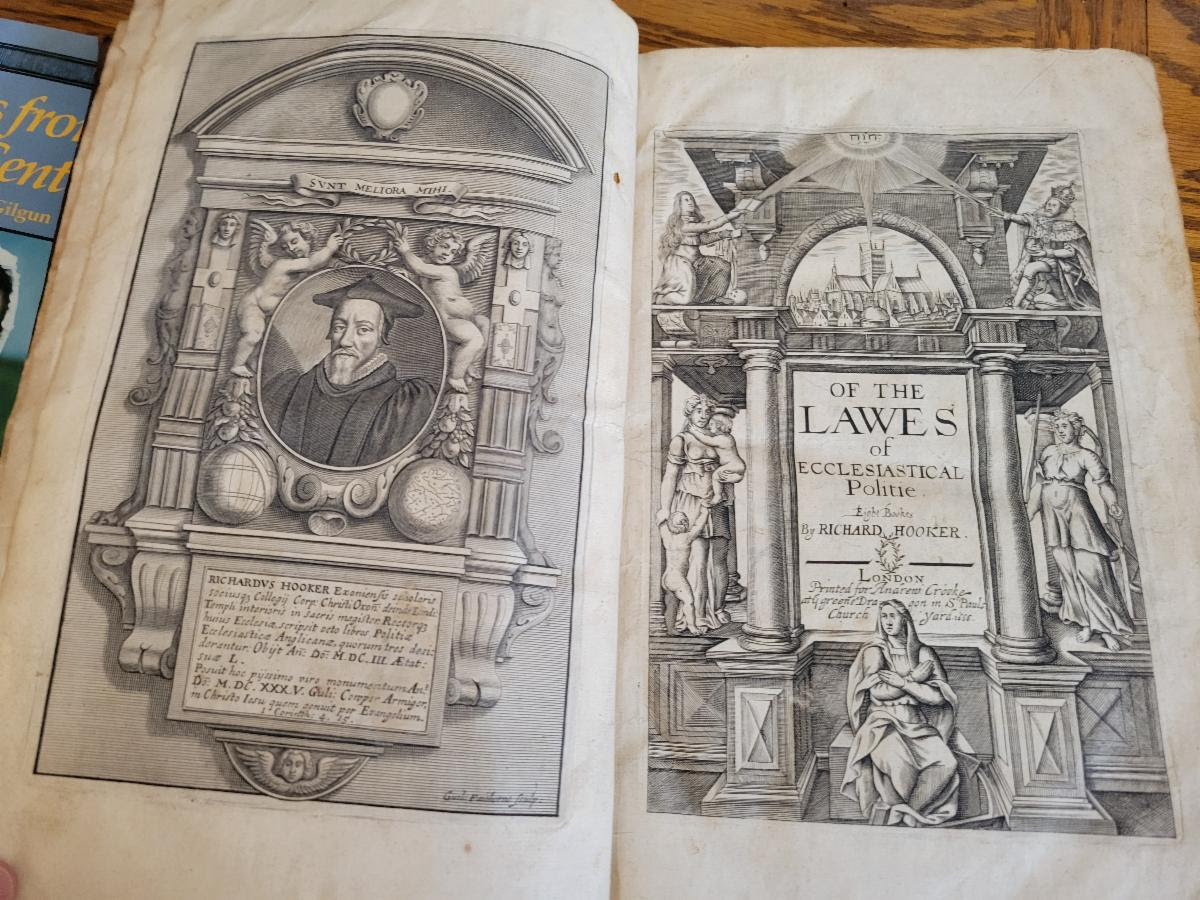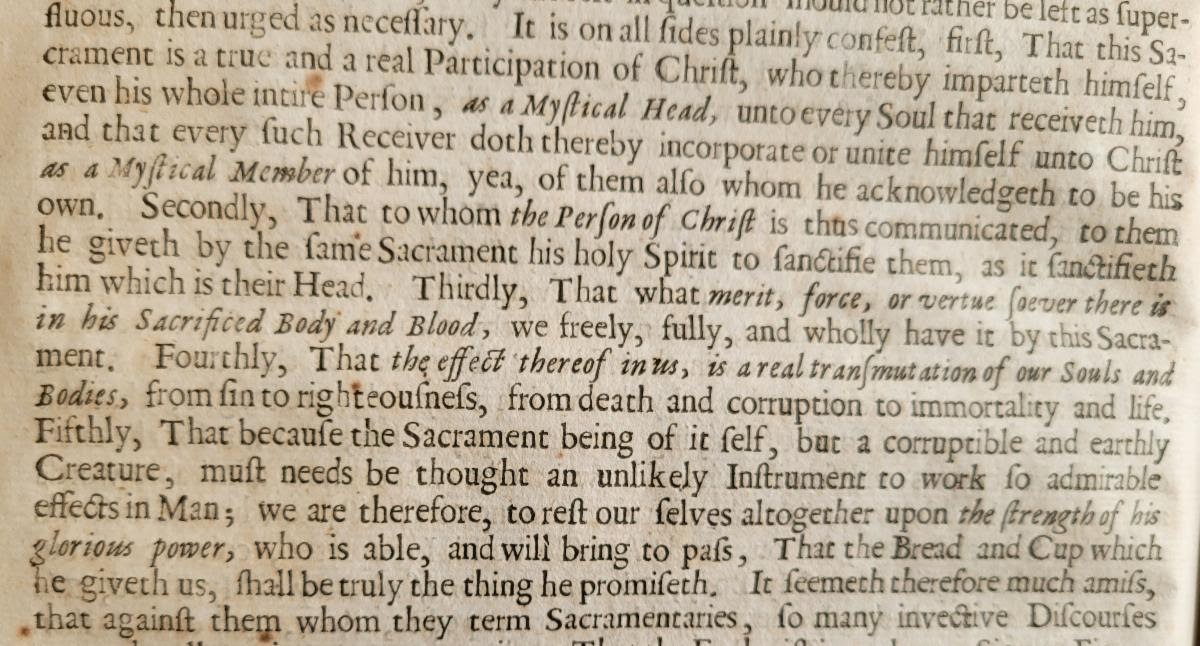358-Year-Old Book Found in Old North’s Archive Room
By The Rev’d Dr. Matthew Cadwell, Vicar of Old North Church

One of the truths about Old North that I appreciate is how there are always discoveries to be made. Recently, I was giving a tour, and when we were in the archive room on the way up to the bellringers’ chamber, I saw a large old book resting on the ledge. I hadn’t been familiar with it, so I began to leaf through it, only to discover—to my astonishment—that it is a copy of the Works of Richard Hooker, published in 1666! Visitor Experience Manager Julius James had seen it in the shelves and thought it looked interesting, but wasn’t aware of its significance.
Richard Hooker (1554 to 1600), is one of the foundational theologians of the Church of England and the Anglican tradition, writing during the reign of Queen Elizabeth I. Every theological student preparing for ordination in the Episcopal Church, the Church of England, and Anglican churches worldwide likely read at least some Richard Hooker. In my PhD program at Trinity College in the University of Toronto, I took a course specifically on Hooker, and a chapter is devoted to him in my dissertation as the first and most important exemplar of Anglican “comprehensiveness” (we might say inclusiveness), allowing for a diversity of beliefs and practices.
Hooker’s purpose was to defend the practices of the Church of England in the Elizabethan era from its critics on two sides—Roman Catholics and Puritans. For the Puritans, the church was still far too Catholic—maintaining bishops and sacramental rites, continuing to draw from the theologies of the medieval unreformed church. For Roman Catholics, the Church of England was heretical in asserting its independence from the Pope and Rome, as well as for its embrace of some Protestant theologies and practices. Hooker argued against critics on both sides that the Church of England had maintained the most ancient practices, those supported by scripture, while citing human reason as a God-given gift that can and should be used in determining which practices and beliefs are best held. He is sometimes credited with establishing the “three-legged stool” of Anglicanism, comprised of scripture, reason, and tradition. Though, he didn’t articulate it quite that way. Here is what he actually wrote:
“Be it a matter of one kind or of the other, what scripture doth plainly deliver, to that the
first place of credit and obedience is due; the next whereunto is whatsoever any man can
necessarily conclude by force of reason; after these the voice of the Church succeedeth.
That which the Church by her ecclesiastical authority shall probably think and define to
be good or true, must in congruity of reason overrule all other inferior judgments whatsoever.”

Other traditions cite scripture, reason, and tradition as sources of authority, as well. Anglicanism is not unique in that regard. But it is how Hooker brought them together that has been influential, critical in the growth and development of Anglicanism in his time and following.
Richard Hooker is likewise significant in his presentation of the sacraments, particularly his approach to the Holy Eucharist. In the Reformation era, faithful Christians were sometimes burned at the stake for holding “incorrect” beliefs about the Eucharist and the manner of Christ’s presence therein. For some, Christ was physically present in the bread and wine. For some, the elements were no longer bread and wine at all, but had become fully and only the Body and Blood of Christ. While for others, the Eucharist was a memorial—a remembrance of Jesus’s last supper—but the bread and wine themselves did not materially change. And, there were ranges of belief in between—for example, that Christ was spiritually but not physically present in the eucharistic elements or that Christ’s Body and Blood were present alongside the visible elements.
While Hooker did not attempt to reconcile these several belief systems (he personally favored a view in which Christ was spiritually present in the faith of the recipient), he looked behind and beneath them all to find God’s promises. He argued that what we believe (given our limited capacities) is less important than the truth of God’s promises and the effect the sacrament has on us. In large respect, this has been the Anglican position since. We try not to overly define such matters, because we can’t truly know the full mysteries of God. What we do know, with confidence, is that the sacrament has a transformative effect—changing us as much, or more, as the bread and wine. Here is what he writes on this subject:
“It is on all sides plainly confessed, first that this sacrament is a true and a real participation in Christ, who thereby imparteth himself even his whole entire person as a mystical Head unto every soul that receiveth him, and that every such receiver doth thereby incorporate or unite himself unto Christ as a mystical member of him, yea of them also whom he acknowledgeth to be his own; secondly, that to whom the person of Christ is thus communicated, to them he giveth by the same sacrament his Holy Spirit to sanctify them as it sanctifieth him which is their head; thirdly that what merit, force, or virtue soever there is in his sacrificed body and blood, we freely fully and wholly have it by this sacrament; fourthly that the effect thereof in us is a real transmutation of our souls and bodies from sin to righteousness, from death and corruption to immortality and life; fifthly that because the sacrament being of itself but a corruptible and earthly creature must needs be thought an unlikely instrument to work so admirable effects in man, we are therefore to rest ourselves altogether upon the strength of his glorious power who is able and will bring to pass that the bread and cup which he giveth us shall be truly the thing he promiseth.”

While convinced of the truth in his own position, Hooker sought to draw all parties to the center, to focus on agreement rather than dispute. This has contributed to Anglicanism’s ability to hold diversities in belief and practice, sometimes imperfectly, but often graciously (when we are at our best—and when we are not and dissolve into dispute, we can always return to Richard Hooker for inspiration and redirection).
It is significant that this volume was included in Old North’s ancient library. It may be the oldest artifact we have (aside from the sanctuary’s Baroque angel statues), printed in 1666—57 years before the church was built. In fact, it was printed before the Church of England was permitted in colonial Boston, and only a few years after the restoration of the monarchy and the Church of England’s reestablishment at the end of the Commonwealth period. This volume is dedicated to King Charles II with a dedicatory letter meant to inspire the king with the teachings and practices of the Church of England from the time of its flourishing under Queen Elizabeth. Our records indicate that this volume was gifted to Old North in 1727, just a few years after our founding.
We can imagine the book’s significance to the Rev’d Dr. Timothy Cutler, Old North’s first rector. He was himself a convert from the Congregational Church and the New England Puritan tradition, who wouldn’t have had much Anglican theological education prior to his ordination in England. But following his return, as he undertook ministry here, he would have been called upon to defend and articulate the practices of our church, minority and suspect that it was, in sometimes hostile territory. Richard Hooker would have been incredibly helpful in that task. Not only in defense of Anglican teachings and practices, but also in helping others to appreciate the truth and profound grace that is the foundation of the tradition. We know that many were drawn here by the hope and inspiration offered. 300 years later, they still are.
